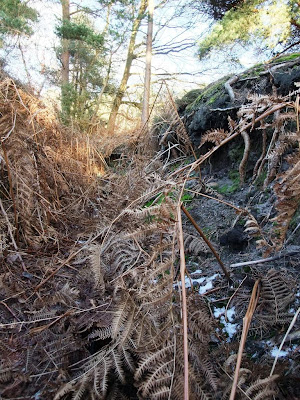Made the most of a beautiful sunny day yesterday recording at Westleton Walks. I am nearing the completion of recording on this particular site after three years of exploring. The next task, as already mentioned in previous posts will to be and try and bring it all together and and interpret the remains.The next couple of posts will look at the most interesting features recorded today, again all training earthworks.
Y Shaped Trench:
Perhaps the best trench remaining on the Walks. It is approx 5ft wide and over 5ft deep in places. There is a weapons-pit on each of the 'long arms' of the Y. It bears some resemblance to an earthwork shown in the 1925 manual Field Works (All Arms). Nearby is another large pit, with remains of angle iron revetting, connected to a crawl trench (see plan). This looks to wide for a weapons-pit, perhaps the remains of a dugout?
Above: GPS plan of Y shaped trench and Y shaped defended post, Manual Of Field Works (All Arms) 1925. The pictures of the trench taken last year (remains of snow on ground!).
Trench and pits
Not far away is another trench system. The first part of the trench is over 3 1/2 ft deep but then continues as a much shallower crawl trench, ending in a weapons-pit. Two short crawl trenches run off the main trench. In the immediate area are a series of slits and a pit dug into an existing bank (the bank is shown by a dotted line on the plan).
Above: GPS plans of trench and pits and a detailed plan of the trench. Photo shows the deepest part of the trench.









Dear Dave,
ReplyDeleteI have read your inspiring article on Thinkdefence.co.uk on interwar field defences (http://www.thinkdefence.co.uk/2011/02/inter-war-field-defences/) and I have a few questions to ask. I am currently looking into the field defences of Hong Kong (a British colony until 1997) before the Second World War. In HK there are pillboxes similar to type illustrated in the 1936 R.E. Manual (the concrete machine-gun emplacement as it was called). I would like to know if there were any other types of pillboxes shown in the 1936 R.E. Manual? If that is the case, is it possible for you to scan those pages and post them to your website or send them to me? I would also like to know if the 1936 R.E. Manual was the first contained drawings of concrete pillboxes (WO issued a 1933 Field Defence Manual for all arms but I was not sure if it contained drawings of concrete pillboxes).
Thank you very much for your kind attention!
Cheers,
Kwong